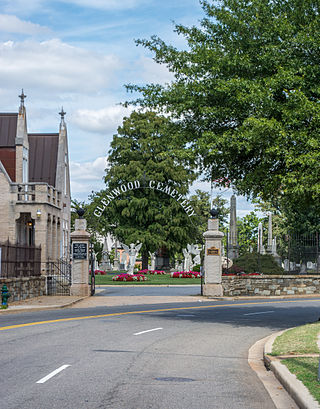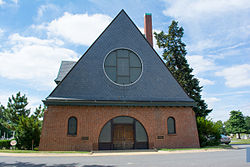
Oak Hill Cemetery is a historic 22-acre (8.9 ha) cemetery located in the Georgetown neighborhood of Washington, D.C., in the United States. It was founded in 1848 and completed in 1853, and is a prime example of a rural cemetery. Many famous politicians, business people, military people, diplomats, and philanthropists are buried at Oak Hill, and the cemetery has a number of Victorian-style memorials and monuments. Oak Hill has two structures which are listed on the National Register of Historic Places: the Oak Hill Cemetery Chapel and the Van Ness Mausoleum.
Glenwood Cemetery may refer to: (sorted by state, then city/town)

Arnos Vale Cemetery, in Arnos Vale, Bristol, England, was established in 1837. Its first burial was in 1839. The cemetery followed a joint-stock model, funded by shareholders. It was laid out as an Arcadian landscape with buildings by Charles Underwood. Most of its area is listed, Grade II*, on the Register of Historic Parks and Gardens of special historic interest in England.

Glenwood Cemetery is a historic rural cemetery northeast of Parker Street and Great Road in Maynard, Massachusetts. It is one of the first municipal creations of the town after its incorporation in 1871, and is the resting place of many of its early and prominent residents, including Amory Maynard, founder of the Assabet Woolen Mill and namesake of the community. The cemetery was added to the National Register of Historic Places (NR#04000425) on May 12, 2004.

The Union Chapel, now known as St. Andrew's Episcopal Church, is a historic church located near Glenwood, Howard County, Maryland, United States. It is a rectangular two-story building of stuccoed stone construction painted pastel yellow completed in 1833 for $1,459. To the rear of the chapel is the attractively landscaped non-sectarian Oak Grove Cemetery. Charles Dorsey Warfield, a member of the prominent Warfield family that settled this region, deeded the property to the residents of the area for non-denominational church and community use. The building was constructed for $5,040 In 1886, it became part of the Methodist church circuit.

Glenwood is an unincorporated community in Howard County, Maryland, United States. It is located between Baltimore and Washington, D.C., therefore attracting commuters to those employment centers. The community features acres of open space and is districted to Bushy Park Elementary, Glenwood and Folly Quarter Middle, and Glenelg High schools. Union Chapel was listed on the National Register of Historic Places in 1975 and Round About Hills was added in 2008. The population in 2020 was approximately 3,416.

The Oak Hill Cemetery Chapel, also known as the Renwick Chapel or James Renwick Chapel, is a historic building in the Georgetown neighborhood of Washington, D.C., United States. Designed by James Renwick Jr. in 1850, Oak Hill Cemetery Chapel is the architect's only known example of Gothic Revival church architecture in Washington, D.C. It is located on the highest ridge in Oak Hill Cemetery, near the intersection of 29th and R Streets NW. The chapel is one of two structures in Oak Hill Cemetery listed on the National Register of Historic Places, the other being the Van Ness Mausoleum. The chapel, mausoleum, and cemetery are contributing properties to the Georgetown Historic District, a National Historic Landmark.

The Panteón Nacional Román Baldorioty de Castro is a tract of land in Barrio Segundo of the city of Ponce, Puerto Rico, originally designed as the city's cemetery, but later converted into what has come to be a famous burial place. Established in 1842, it is Puerto Rico's first national pantheon. It is the only cemetery dedicated as a museum in Puerto Rico and the Caribbean. Prior to being dedicated as a Panteón Nacional, it was known as Cementerio Viejo or as Cementerio Antiguo de Ponce, and is listed under that name on the U.S. National Register of Historic Places. The Pantheon is named after Román Baldorioty de Castro, a prolific Puerto Rican politician, and firm believer of Puerto Rican autonomy and independence. His remains are located here. The Pantheon also houses a small museum about the history of autonomism in the Island, and it is currently used both as a park and a venue for the expression of culture and the arts. It is called the Museo del Autonomismo Puertorriqueño.

The Oak Hill Cemetery Chapel is a historic chapel, located in the Oak Hill Cemetery off Pleasant Street in Bellows Falls, Vermont. Built about 1885, it is one of a small number of 19th-century cemetery chapels in the state, and is the most modestly decorated of those, with vernacular Gothic Revival elements. The building was listed on the National Register of Historic Places in 1991.

The Howard Mortuary Chapel is a historic chapel located at 455 North Avenue on the grounds of Lakeview Cemetery in Burlington, Vermont. Built in 1882, the chapel was designed in the High Victorian Gothic style by Alfred Benjamin Fisher, on cemetery grounds designed by E. C. Ryer in 1871. It was given to the City of Burlington by Hannah Louisa Howard. The chapel was added to the National Register of Historic Places in 1999.

Brandwood End Cemetery is a cemetery located in the Brandwood ward of Birmingham, England.

The Medford IOOF Cemetery in Medford, Oregon, also known as Medford Odd Fellows Cemetery and as Eastwood–IOOF Cemetery, was founded in 1890. The cemetery was managed by the IOOF Lodge until 1969 where maintenance was transferred to the City of Medford, where it remains today.

Glenwood Cemetery is a historic cemetery located at 2219 Lincoln Road NE in Washington, D.C. It is a private, secular cemetery owned and operated by The Glenwood Cemetery, Inc. Many famous people are buried in Glenwood Cemetery, and the cemetery is noted for its numerous elaborate Victorian and Art Nouveau funerary monuments. The cemetery was listed on the National Register of Historic Places in 2017; its mortuary chapel was separately listed in 1989.

Glenn Brown was an American architect and historian.

The Brady Memorial Chapel is a historic chapel in Mountain View Cemetery in Pocatello, Idaho.

Hillside Cemetery is a historic rural cemetery located at Clarendon in Orleans County, New York. The cemetery was established in 1866, and is the resting place of many early settlers. The cemetery includes a mortuary chapel built in 1894 in the Gothic Revival style and stucco over concrete storage building (1928). The last section of the cemetery was added in 1938.

The Glenwood Archeological District is a nationally recognized historic district and archaeological sites located near Glenwood, Iowa, United States. It is one of nine sites from the Nebraska Phase of the Woodland period recognized by archaeologists, and the only one located east of the Missouri River. The district is made up of earth lodge sites, mortuary sites and artifact scatters from the Glenwood culture. They date from sometime between 1250 and 1400 C.E. The district was listed on the National Register of Historic Places in 2013.

Union Cemetery Gardener's Cottage is a historic building located in Iowa Falls, Iowa, United States. When the town was platted in 1855 there was no provision for a cemetery. The women of the community formed the Social Gathering of Iowa Falls with the purpose of establishing a cemetery. They raised money and purchased the first 4.5 acres (1.8 ha) in 1860 from the three men who laid out Iowa Falls. By 1900 the organization minutes began referencing the need for the building for the sexton during stormy weather. It was not until 1918 that the Ladies Social Gathering authorized the construction of a building that they called a chapel and mortuary. The single-story American Craftsman cottage was designed by W.L. Peddicord. While it was used for a variety of functions, it appears that it was never used as a chapel. It has generally been used to house the sexton's tools, and it has been used as the cemetery office. The building was listed on the National Register of Historic Places in 2002.

Glenwood Cemetery is a cemetery located at 2500 W Court Street in Flint, Michigan. It was listed on the National Register of Historic Places in 2010.


















